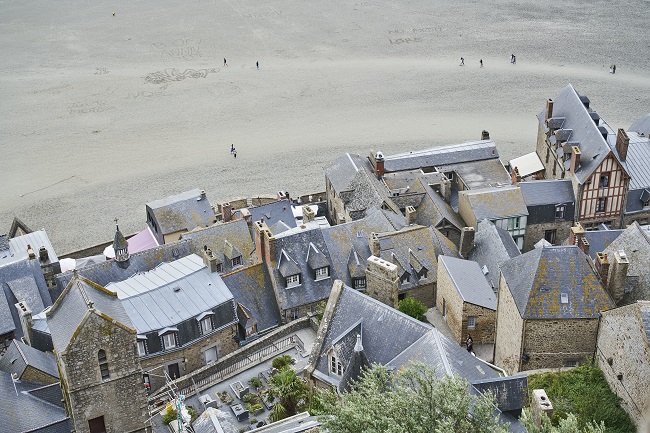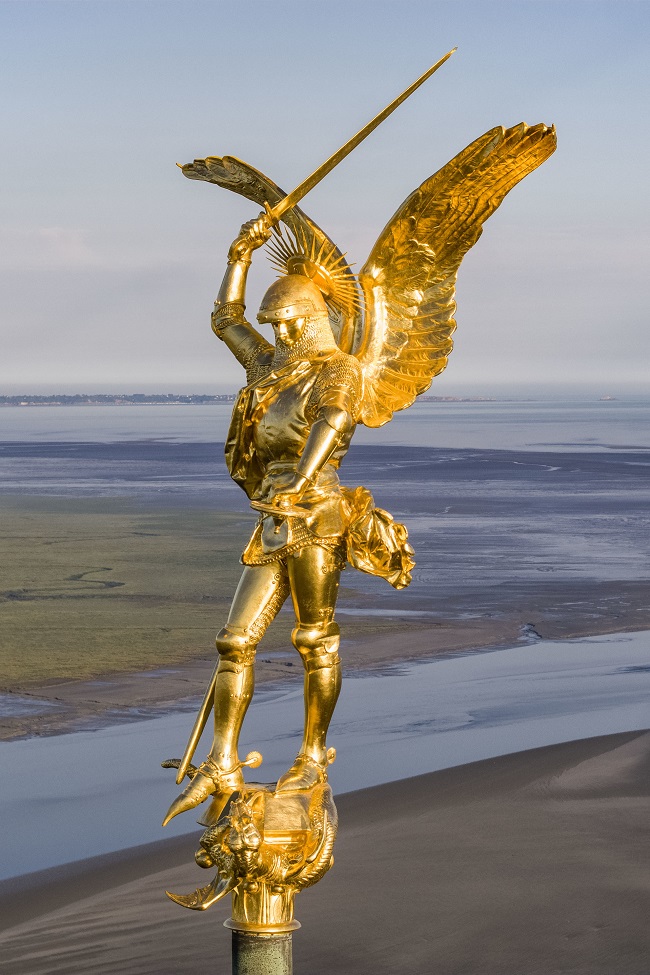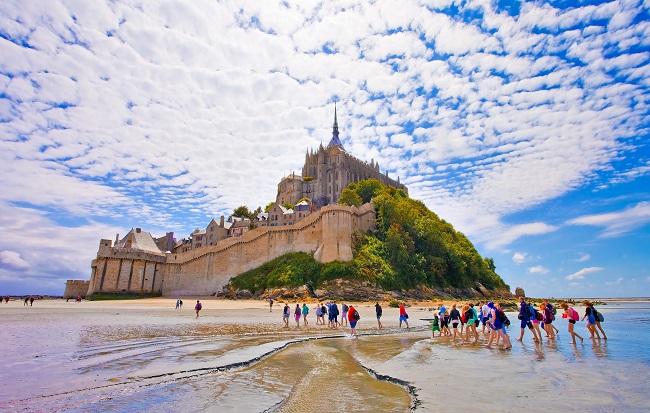French Monument of the Month: the Mont Saint-Michel Abbey
Sponsored
In this monthly series, we take a look around France’s many beautiful historical buildings under the care of the Centre des Monuments Nationaux. This month, the Mont Saint-Michel and its historic Abbey, whose church is celebrating its 1000th anniversary.
If you ever needed an excuse to visit (or revisit) the majestic Mont Saint-Michel, how about celebrating one millennium since construction of the abbey’s Romanesque nave began in 1023?
The heritage treasure needs no introduction. Located on a tidal island just off the coasts of Normandy and Brittany, Mont Saint-Michel is universally recognised as a site of spiritual and historical significance. The Gothic-style Benedictine abbey dedicated to the Archangel St Michael was France’s second UNESCO World Heritage induction after the Cathedral of Chartres, and to this day is one of France’s most popular sites with over three million visitors a year.

A view of the cloister of Mont Saint-Michel’s abbey © Thomas Thibaut / Centre des Monuments Nationaux
A place of spirituality and knowledge
Legend has it that, in 708, the bishop Aubert dreamt of the archangel Michael asking him to build a sanctuary in his name upon the Mont-Tombe. This first holy place was then occupied in 966 by Benedictine monks and the construction of an abbey began in 1023. The presence of the monks and the building site of the abbey attracted pilgrims who flocked to the island seeking salvation and protection from St Michael. A village started to settle at the foot of the small mountain.
Meanwhile, the abbey began to produce, preserve and study a large number of manuscripts. It then became a major cultural site during the Middle Ages. The abbey welcomed pilgrims of all backgrounds, including several kings of France and England, such as Henri II Plantagenêt, Saint Louis, Louis XI, Anne of Brittany, François I…
Different architectural additions throughout the years have created a very unique religious site with Gothic elements added to the first church. The abbey was also built almost like a fortified castle, clinging to the rocky outcrop at the top of the mont and shooting upwards, with thick, tall walls surrounding it. It actually served as a fortress for the Duchy of Normandy and it survived the Hundred Years’ War including a series of brutal English sieges between 1423 and 1434. Though the Roman choir of the church collapsed, the Mont Saint-Michel became a symbol of French triumph.

Stunning aerial view of the Abbey church © Christian Gluckman / Centre des Monuments Nationaux
From pilgrims to prisoners
In the 17th century, the Mont Saint Michel was commandeered as a prison and the monks who lived there had to oversee the arrival of prisoners in what was then known as the ‘Bastille of the Seas’, a reference to the infamous Parisian prison tower.
After the French Revolution and the subsequent separation of Church and State saw the clergy’s properties nationalised, the monks were ushered away from the Mont Saint Michel. But the prisoners remained and the island played host to political prisoners such as Auguste Blanqui or Armand Barbès.
Though a dark period in the site’s history, its conversion to a prison, which held 14,000 prisoners throughout the years, undoubtedly saved it from destruction. In 1863, the prison doors were closed forever on an abbey that was is pitiful state.

The village at the foot of the Abbey © Thomas Thibaut / Centre des Monuments Nationaux
Revival and restoration
The abbey was listed as a Monument Historique in 1874 and renovations began immediately to preserve the site and prepare to receive its first tourists. A road leading to the island from the coast was built in 1879 to make the site more accessible and overcome the tidal constraints of the sea. This meant however, that the island lost its maritime heritage. Between 1901 and 1938, a steam tramway even linked Mont Saint-Michel to Pontorson!
Following the celebration of the monastic millennium in 1965-1966, a small community of Benedictine monks came to settle in the abbey. In 2001, it was replaced by the Monastic Fraternities of Jerusalem. Today, a dozen monks and nuns live within this national monument and welcome pilgrims from around the world.
The Mont Saint-Michel was the second French site to receive UNESCO World Heritage status in 1979 and it was also recognised as part of the Santiago de Compostela pilgrimage route, highlighting the exceptional historical value of the site.

The Archangel Michael stand at the top of the church spire © Christian Gluckman / Centre des Monuments Nationaux
Visit the Mont Saint-Michel today
Whatever way you choose to approach – by car, bike, foot or horse-drawn carriage – the magnificence of Mont Saint-Michel is guaranteed to stop you in your tracks. As well as a remarkably preserved heritage, the Mont Saint-Michel, offers a wonderful cultural program with exhibitions, concerts and events held year-round.
To celebrate the millennium anniversary of the abbatial church, an exceptional exhibition is currently held within the Abbey. ‘La Demeure de l’Archange’ (the home of the archangel) brings to life the history of the site, including its many reconstructions and renovations, as well as the creation that took place there. Five different eras and themes are presented during the exhibition: the challenges of the terrain faced by builders, the abbey of Mont-Saint-Michel in the classical period, restorations and creations in the 19th century, the founding saint and the final adornments brought together by a bishop, an architect and a goldsmith.
Running until November 5th 2023, the exhibition brings together 30 exceptional pieces, works of art and religious objects, within the very heart of the church whose history they shed light on.
For more information, visit www.abbaye-mont-saint-michel.fr
Lead photo credit : The majestic Mont Saint-Michel reigns over its bay of the coast of Normandy and Brittany © shutterstock
Share to: Facebook Twitter LinkedIn Email
More in abbey, exhibition, French history, Mont Saint Michel, Monument Historique, monument of the month
Leave a reply
Your email address will not be published. Required fields are marked *






REPLY
REPLY
REPLY
REPLY